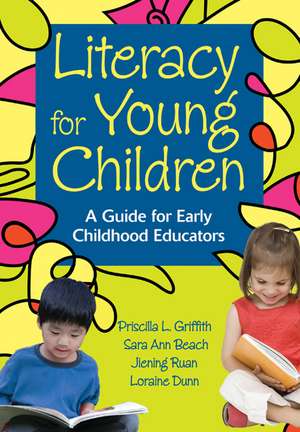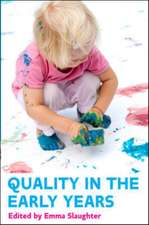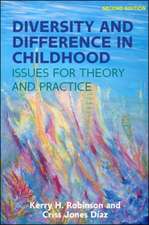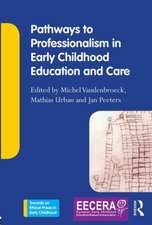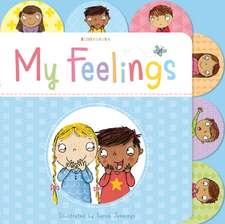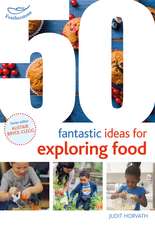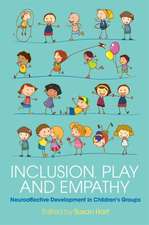Literacy for Young Children: A Guide for Early Childhood Educators
Autor Priscilla L. Griffith, Sara Ann Beach, Jiening Ruan, A. Loraine Dunnen Limba Engleză Paperback – 5 mai 2008
| Toate formatele și edițiile | Preț | Express |
|---|---|---|
| Paperback (1) | 287.62 lei 6-8 săpt. | |
| SAGE Publications – 5 mai 2008 | 287.62 lei 6-8 săpt. | |
| Hardback (1) | 576.94 lei 6-8 săpt. | |
| SAGE Publications – 5 mai 2008 | 576.94 lei 6-8 săpt. |
Preț: 287.62 lei
Nou
55.04€ • 59.97$ • 46.38£
Carte tipărită la comandă
Livrare economică 23 aprilie-07 mai
Specificații
ISBN-10: 141295200X
Pagini: 256
Dimensiuni: 178 x 254 x 15 mm
Greutate: 0.53 kg
Ediția:1
Editura: SAGE Publications
Colecția Corwin
Locul publicării:Thousand Oaks, United States
Recenzii
"Griffith and her colleagues have written a valuable book for literacy instructors. The attention to detail and the inclusion of research-based instructional strategies will make this book an excellent resource for all teachers and coaches in grades preK and K."
"This book merges the five big ideas in reading with developmentally appropriate practice to create a practical guide that will enhance literacy development in any type of preschool setting. The references, resources, and examples will help teachers bring these ideas to life in their classrooms."
"A great resource for any early childhood teacher! The book provides concrete examples of how to implement best practices in an early childhood classroom. By connecting all the big ideas in literacy, the authors have set a standard for best practice!"
"This clear, concise text allows the reader a look into the classroom and an opportunity to relate to students and teachers in specific and meaningful ways to address literacy and its many important parts."
"A major strength of this book is the focus on addressing the needs of each child as an individual, supporting his or her literacy development through both the physical and the interactional environment. I look forward to using this book in my literacy methods courses."
Cuprins
About the Authors
Introduction: Why Early Literacy?
Early Reading First
Developmentally Appropriate Practice
Overview of This Book
Chapter 1. Children's Development and Literacy Learning
How Children Develop and Learn
Child Development: The Foundation for Literacy
Introducing Rebecca, Juan, Michael, and Annie
Foundations for Learning to Read
Supportive Classroom Environments
Summary
Chapter 2. Language Development and Diversity
Role of Oral Language in Literacy Development
What Does Research Say About How Children Acquire Language?
Benchmarks of Oral Language Development for Preschool Children
Assessing Oral Language Development
Research-Based Instructional Strategies Supporting Oral Language Development
Language Diversity
Summary
Chapter 3. Phonological Awareness Development in Preschool Children
What Is Phonological Awareness and What Is Its Role in Literacy Development?
What does Research Say About How Children Acquire Phonological Awareness?
Indicators of Children's Development of Phonological Awareness
Assessing Phonological Awareness
Research-Based Instructional Strategies Supporting Phonological Awareness
Addressing Diversity
Summary
Chapter 4. Alphabetic Principle
What Is the Alphabetic Principle and What is Its Role in Literacy Development?
What Does Research Tell Us About the Alphabetic Principle?
Assessing the Alphabetic Principle
Research-Based Instructional Strategies Supporting Understanding of the Alphabetic Principle
Addressing Diversity
Summary
Chapter 5. Writing
How Are Reading and Writing Connected in Early Literacy Development?
What Does Research Say About Emergent Writing Development?
Assessing Writing
Research-Based Instructional Strategies to Support Emergent Writing
Addressing Diversity
Summary
Chapter 6. Comprehension: Making Meaning
What Is Comprehension?
What Helps Children Comprehend?
Assessing Comprehension
Research-Based Instructional Strategies
Addressing Diversity
Summary
Chapter 7. Sharing Books With Children
The Importance of Book Sharing for Children's Early Literacy Development
What Does Research Say About Storybook Reading With Children?
Selecting High-Quality Children's Literature
Developing Classroom Libraries
Research-Based Instructional Strategies for Sharing Books With Children
Addressing Diversity
Summary
Chapter 8. Integrating Literacy Across the Curriculum
Integrated Curriculum
Planning an Integrated Unit
Summary
Chapter 9. Literacy in the Real World
Language and Literacy in Communities
Infusing Home and Community Literacy in the Classroom
Summary
Chapter 10. Helping Parents Facilitate Children's Literacy at Home
Why Parents Become Involved
Parental Beliefs
Types of Parental Involvement
Why Parental Involvement?
Summary
Chapter 11. Bringing It All Together
Preschool Programs Make a Difference
The Physical Environment
The Interactional Environment
Assessing Your Literacy and Language Environment
Planning Whole and Half Day Programs
Summary
References
Children's Books Referenced
Additional Resources for Teachers
Helpful Websites
References
Index
Notă biografică
Priscilla L. Griffith is the Ruth G. Hardman Chair in Education and a Professor in the Department of Instructional Leadership and Academic Curriculum at the University of Oklahoma where she teaches undergraduate and graduate level literacy education courses. Priscilla has worked in language and literacy, and teacher education for over three decades. She has applied her expertise in these areas as an editor of professional journals including The Reading Teacher and Action in Teacher Education, as a consultant for school districts, and as a classroom teacher. She has worked with Pre-K teachers in Early Reading First classrooms. In addition, Priscilla works regularly with teachers as Director of the Oklahoma Writing Project, a site of the National Writing Project. She is a past president of the Florida Reading Association and the Oklahoma Reading Association. Priscilla received her Ph.D. degree from the University of Texas at Austin.
Descriere
Vignettes of 4 ethnically and geographically diverse children illustrate principles in practice
